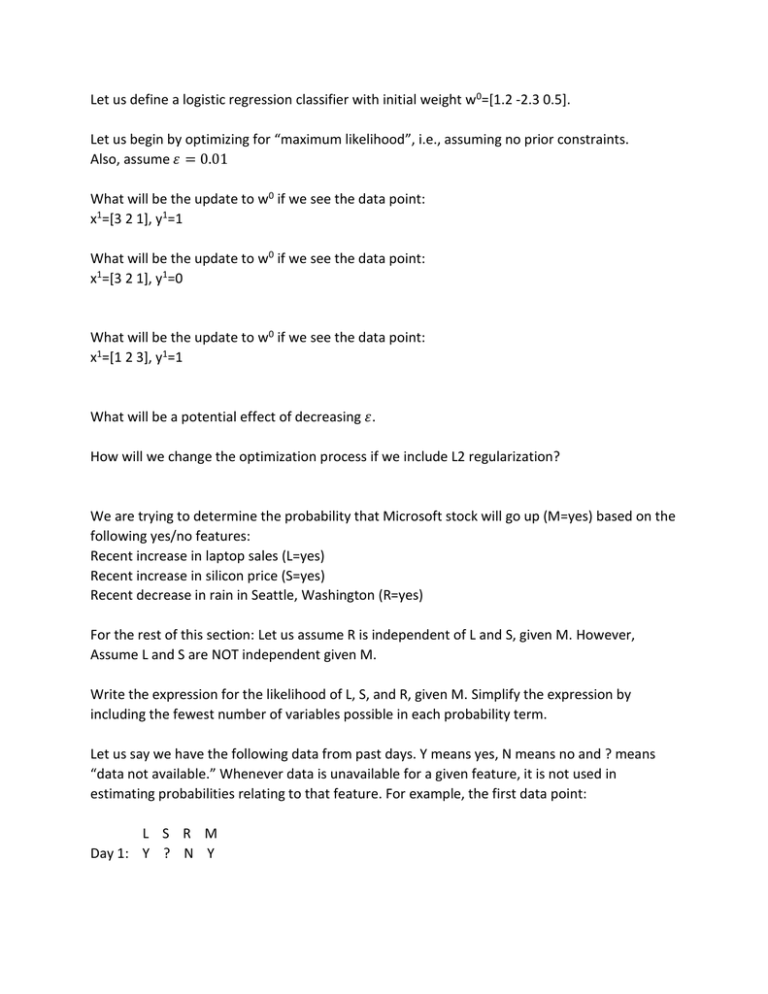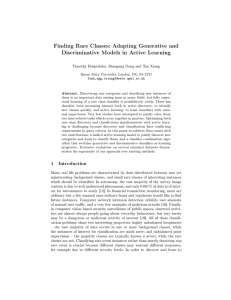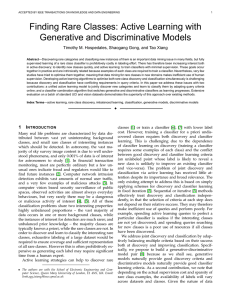Let us define a logistic regression classifier with initial weight w0
advertisement

Let us define a logistic regression classifier with initial weight w0=[1.2 -2.3 0.5].
Let us begin by optimizing for “maximum likelihood”, i.e., assuming no prior constraints.
Also, assume 𝜀 = 0.01
What will be the update to w0 if we see the data point:
x1=[3 2 1], y1=1
What will be the update to w0 if we see the data point:
x1=[3 2 1], y1=0
What will be the update to w0 if we see the data point:
x1=[1 2 3], y1=1
What will be a potential effect of decreasing 𝜀.
How will we change the optimization process if we include L2 regularization?
We are trying to determine the probability that Microsoft stock will go up (M=yes) based on the
following yes/no features:
Recent increase in laptop sales (L=yes)
Recent increase in silicon price (S=yes)
Recent decrease in rain in Seattle, Washington (R=yes)
For the rest of this section: Let us assume R is independent of L and S, given M. However,
Assume L and S are NOT independent given M.
Write the expression for the likelihood of L, S, and R, given M. Simplify the expression by
including the fewest number of variables possible in each probability term.
Let us say we have the following data from past days. Y means yes, N means no and ? means
“data not available.” Whenever data is unavailable for a given feature, it is not used in
estimating probabilities relating to that feature. For example, the first data point:
L S R M
Day 1: Y ? N Y
can be used in the estimation of P(L=yes) and P(M=yes | R=no), but it cannot be used in the
estimation of P(L=yes,S=yes|M=yes)
Data:
Day 1:
Day 2:
Day 3:
Day 4:
Day 5:
Day 6:
Day 7:
Day 8:
L
Y
Y
?
?
N
N
Y
?
S
?
Y
Y
?
N
?
?
N
R
N
N
N
Y
?
?
Y
Y
M
Y
N
Y
N
Y
Y
Y
Y
Which of the probabilities below have Maximum Likelihood Estimate of 0? What are the nonzero values?
P(M=yes)
P(L=yes,S=yes|M=no)
P(L=no,S=no,R=yes|M=yes)
P(L=no,S=yes|M=yes)
To calculate the a posteriori probability of P(L=no,S=no|M=yes), how do we incorporate a prior
belief that there is a 20% chance Microsoft stock will fall or stay the same?
Let us consider a binary classification problem. For several objects in an online store, we wish to
train a classifier to predict the label: “Does this object make people happy?” (variable
H={yes,no}) We will use five features:
How big is it?
How old is it?
How expensive is it?
How familiar is it?
How natural is it?
Each feature will take on an integer value from 1 to 10, inclusive.
Assuming all features are independent, how many parameters must be learned for the
classifier?
How many features do we learn if we wish to categorize each object into three different “make
people happy” classes (including scores 1 – really makes people sad, 2 – neutral in affecting
happiness, and 3 – really makes people happy).
Compute triangle distribution
Let us assume a single-feature data set in which each data point comes from one of two
distributions:
1
0≤𝑥≤𝑎
For class 0: a uniform distribution starting x and ending x =a, 𝑓(𝑥) = { 𝑎
0 𝑜𝑡ℎ𝑒𝑟𝑤𝑖𝑠𝑒
Class 1: a triangle distribution, starting at x=0 and ending at x=b:
2
𝑥
ℎ(𝑥) = {𝑏 (1 − 𝑏) 0 ≤ 𝑥 ≤ 𝑏
0
𝑜𝑡ℎ𝑒𝑟𝑤𝑖𝑠𝑒
Given N data points (xi,yi) in a training set, what is the formula for the likelihood, given the
parameters a and b? (You may express your answer in terms of f(x) and h(x).)
Assuming all data points are positive, what is the maximum likelihood estimate for a and b?
Calculus will not help you here. You actually have to use your intuition!
Consider points below and select four as likely support vectors for a linear separator. Draw your
estimate of the separator and calculate the w value, assuming all support vectors have alpha=1.
What is the purpose of a slack variable? (Will be covered October 21.)
Suggest the two classification methods from the list below most fitting the following data:
(Some of the material will be covered October 21.)
Bayes classifier
Logistic regression
Linear SVM
Kernel SVM (i.e., SVM with dimension mapping function)
SVM with slack variables
In Dr. Lyons’ talk, he addressed uncertainty in robot navigation. What were two things the
robot estimated during its navigation through an environment.
What is overfitting?
We wish to use a Maximum Likelihood Bayesian classifier to determine whether we are at a
fruit stand (variable F) based on the presence of bananas (variable B), milk (variable M), and
cash registers (variable C). We assume B, M, and C are all independent of one another given
the value of F. Based on training data, we have found the following probabilities:
P(B=yes|F=yes) = 0.8
P(B=yes|F=no)=0.2
P(M=yes|F=yes)=0.1
P(M=yes|N=no)=0.5
P(C=yes|F=yes)=0.7
P(C=yes|F=no)=0.6
We observe cash registers, but no bananas or milk. Does the Maximum Likelihood classifier
conclude we are in a fruit stand?
We observe bananas, but no milk or cash registers. Does the Maximum Likelihood classifier
conclude we are in a fruit stand?




![School Risk Register [DOCX 19.62KB]](http://s2.studylib.net/store/data/014980461_1-ba10a32430c2d15ad9059905353624b0-300x300.png)



